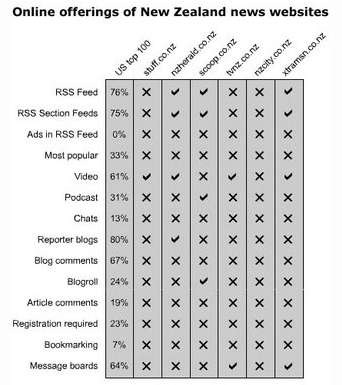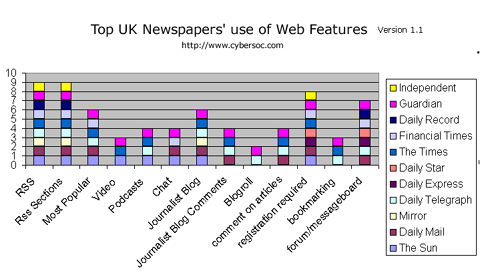So this is how open source reporting works. On August 1, The Bivings Group released a research report of how the Top 100 U.S. newspaper websites were implementing features such as blogs, podcasts and social bookmarking. (I summarized the findings here.) By August 10, three bloggers located outside the U.S. took it upon themselves to do a similar study of their own country’s top newspaper sites to see how they stacked up to their American counterparts. And one German blogger set up a wiki to track results for German newspaper sites.
Soon the Bivings Group was putting out a Call for Newspaper Research asking for people in other countries to send in their findings. Plus, the Bivings Group posted its latest research on Japanese newspaper sites. In the space of a few days, the project shifted from one focused on the U.S. to one with a global footprint, thanks to volunteer researchers who jumped in to help without compensation or even someone asking them to do it.
“The collective research is exciting and a good example of what’s great about the Internet,” said Todd Zeigler, head of online PR for Bivings Group, in an email to me. “As far as I can tell, people just started doing their own research spontaneously out of interest in how newspapers in their own countries stacked up. The Italian study was the first sister study and the others came after that.”
The Italian study was the most elaborate of the three, done by blogger/journalist Luca Conti, and is in a 19-page PDF file (in Italian, of course). Conti told me via email that he did the report out of curiosity, wondering how Italian newspaper sites measured up to American sites. But soon, the report paid off for Conti.
“Yesterday I wrote an article for Nova24, a weekly edition dedicated to innovation and technology,” Conti said. “It was my first article for Nova24 and the topic was my study. The PDF [for the study] has been downloaded more than 300 times in a week. The house organ of the National Association of Italian Communication Agencies asked me to write a two page article about the study.”
Other Countries Lag U.S.
In general, the sister studies found that newspaper sites in Italy, New Zealand, Japan and the UK lag behind the American newspaper sites in implementing Web 2.0-type features such as RSS feeds, blogs, podcasts and forums. Keep in mind that the conclusion of the U.S. report was that American sites still had room for improvement.
Conti told me that Italy — a country with 57 million people — has about 18 million active Internet users, with only 6-7 million high-speed DSL users, half of whom are on “pay as you go” data plans. That might help explain why so many Italian newspaper sites have been slow to adopt Web 2.0 features. The chart below compares the Top 25 Italian newspaper sites with the Top 25 American newspaper sites and the Bottom 25 (out of the Top 100) American newspaper sites. (Note that “Piu letti” means a “Most Popular Story” list, and “Salva preferiti” means social bookmarking.)
In only one category do the Italian sites lead even the bottom U.S. sites: forced registration, which isn’t necessarily something you want to lead. Conti points out that the top two Italian newspaper sites are a bit more out in front when it comes to features.
“Italian newspapers have mixed feelings with the Internet,” Conti said. “A small group have feeds, blogs, forums and sometimes something more. A big group (19 out of 50) has a registration wall, usually you have to pay, only for reading articles written for the paper edition. We have a low adoption of Web 2.0 tools. La Repubblica.it is the most read newspaper online and offline. It is the most advanced. It has a real-time PDF edition, many blogs, Internet radio and TV station that also broadcasts on digital terrestrial waves, with audio and video podcasts and many RSS feeds. The second one, Corriere della Sera has feeds, a video edition for the web, no podcasts, no blogs, but many forums.”
Meanwhile, journalist and web designer Fraser Mills did his own study on the Top 6 New Zealand news sites and found they also lagged the U.S. except in video, where the Kiwis came in at 66% to the Americans’ 61% usage (but keep in mind this is of all Top 100 American sites):

Online community specialist Robin Hamman did his own survey of the Top 11 British newspaper sites, which did better than the other countries vs. American sites. The British Top 11 was behind the U.S. Top 10 in video usage (3 vs. 7), podcasts (4 vs. 7) and blogs (6 vs. 9), but led the U.S. in comments on articles (4 vs. 1) and online forums (7 vs. 4).

As for Japan, the Bivings Report found that the top Japanese newspaper sites lagged American sites in almost all categories. In video, the Japanese sites got close (with 11 of the Top 21 offering it), and nearly every Japanese site offered a special page for cell phone surfers.
So why was this such as successful foray into ad hoc open source reporting? I think it was easy for anyone to gauge the features on a newspaper site by just poking around and tallying their offerings. It didn’t require calling up people to survey them or other more time-intensive or expensive research techniques. You just list the results, create a graph, and presto! — you’re an online media research expert.
Of course you might miss something, and with no centralized controls, mistakes might happen. But with centralized control, mistakes happen, too. Plus, you can count on others — especially online newspaper publishers themselves — to correct the record where possible.
I’ll continue to update this post when new research comes in from Bivings Group or other outside sources to try to get a picture of how newspaper sites are doing with Web 2.0 features around the globe.
What do you think about these research results? What about the open source reporting? Is this an example that could be replicated in other fields of research? Share your thoughts in the comments below.

Hi Marc,
Thanks for pointing this out; I’ll do the Belgian media landscape overview ! Opened a public wiki so my fellow Belgian bloggers from the “Belgosphere” can help… We got a lot of newspapers with sites…;-)
Mark:
Here is a snapshot of the media from India. Indian newspapers and online properties appear to have embraced blogging in a pretty significant way. Some of them also allow users to create their own blog sites.
Besides newspapers, TV channels in India have embraced blogging and podcasting in a significant way. In fact, a couple of the major TV stations encourage their viewers (citizen media) to send in their video clips and photos.
I am not sure if anyone has done any kind of research on newspapers and TV in India, and how they have embraced blogs and podcasts.
Kamla
Thanks for pointing this out; I’ll do the Belgian media landscape overview ! Opened a public wiki so my fellow Belgian bloggers from the “Belgosphere” can help… We got a lot of newspapers with sites…;-)
Shukoor Ahmed ran for a seat in the Maryland House of Delegates in 1998, after coming to America a decade earlier from Hyderabad, India. Campaigning door-to-door, he was surprised so many voters did not know who represented them! After his race ended slightly short of victory, he took advantage of his Master’s degree in Computer Technology and Political Science to build StateDemocracy.org, a website he launched in 2001 to connect citizens and lawmakers. His website’s motto encapsulated its mission
Frank F. Islam is a successful entrepreneur and investor based in metropolitan Washington, DC. He is the Chairman/CEO of FI Investment Group LLC (FIIG), an investment firm he founded in 2007. FIIG focuses on providing growth capital to emerging companies, as well as managing specialized and branded funds. His investment style centers on innovative strategies for value creation, such that he is often the first to invest within a new economic paradigm.
Previously, Mr. Islam was the founder and CEO of QSS Group. QSS Group was an Information Technology company which generated a revenue of $300 Million. Through QSS, Mr. Islam garnered multiple industry awards for leadership, entrepreneurship and excellence. In 1999, Mr. Islam was recognized by the Ernst and Young as Maryland Entrepreneur of the Year. The US Small Business Administration selected him as the Small Business Person of the Year of the Washington DC Metropolitan Area in 2001.
Contact Your Elected Officials such as President, Vice-President, US Representatives, US Senators, State Senator. Use Free Political Absentee Ballot Application, Voter Registration Application and Polling Place Locator tools
i want to be among does online
Shukoor Ahmed ran for a seat in the Maryland House of Delegates in 1998, after coming to America a decade earlier from Hyderabad, India. Campaigning door-to-door, he was surprised so many voters did not know who represented them! After his race ended slightly short of victory, he took advantage of his Master’s degree in Computer Technology and Political Science to build StateDemocracy.org, a website he launched in 2001 to connect citizens and lawmakers. His website’s motto encapsulated its mission
wow all those garments are so amazing and fabulous I don’t come to your blog as often as I would like, but whenever I do I see some really amazing things keep up the good work! =)